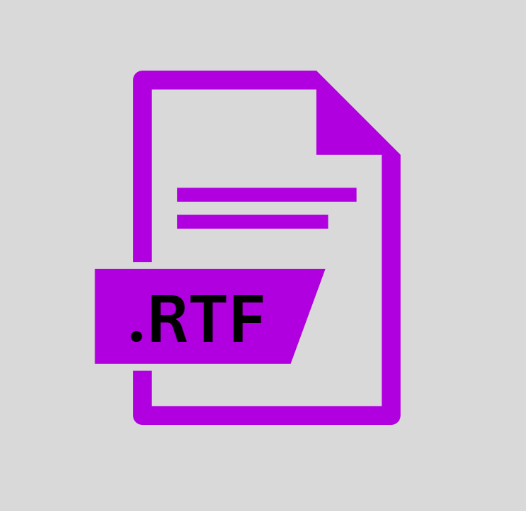.RTF File Extension

Rich Text Format File
| Developer | Microsoft |
| Popularity | |
| Category | Text Files |
| Format | .RTF |
| Cross Platform | Update Soon |
What is an RTF file?
Rich Text Format (RTF) is a type of document file format developed by Microsoft in 1987 for cross-platform document interchange.
Unlike many word processor formats, RTF code can be human-readable: when an RTF file is viewed as a plain text file, the contained ASCII text is generally legible.
The format plays a crucial role in the realm of text documents by ensuring that files can be easily shared and opened across various operating systems and applications without losing their formatting and structure.
More Information.
The initial purpose of RTF was to eliminate compatibility issues by providing a format that various word processors could understand.
In the early days of personal computing, document interchange faced significant challenges due to the variety of word processing applications available, each with its proprietary format.
.RTF sought to bridge this gap by offering a format that preserved document formatting and could be read and written by many word processors.
Origin Of This File.
RTF was developed by Microsoft to provide a format for text and graphics interchange that can be used with different output devices, operating environments, and operating systems.
Version 1.0 of the RTF specification was released in 1987, coinciding with the launch of Microsoft Word 3.0. Since then, most word processing applications, including Microsoft Word, have supported the format.
File Structure Technical Specification.
An RTF file is a text file containing encoded text and control words. The control words are special commands that determine the formatting of the document.
These control words are preceded by a backslash () and are generally enclosed in curly braces ({}). An RTF file starts with an opening curly brace, followed by the control word ‘rtf’, and then the content of the document. The file ends with a closing curly brace. RTF files can contain:
- Text content
- Formatting commands (bold, italics, fonts, etc.)
- Special characters
- Images
- Tables
How to Convert the File?
Converting an RTF (Rich Text Format) file to other formats can be easily done using various software tools and online conversion services.
Here’s a step-by-step guide on how to convert RTF files on different operating systems and devices:
1. For Windows:
Using Microsoft Word:
- Open Microsoft Word.
- Open the RTF file by clicking on ‘File’ > ‘Open’ and selecting the file.
- Once opened, click on ‘File’ > ‘Save As’.
- In the ‘Save as type’ dropdown menu, select your desired format (e.g., DOCX, PDF).
- Choose the location to save the new file and click ‘Save’.
Using Online Converters:
- Go to an online file conversion website.
- Upload your RTF file.
- Choose the format you want to convert it to (e.g., PDF, DOCX).
- Click on the convert button and download the converted file once ready.
2. For Linux:
Using LibreOffice Writer:
- Open LibreOffice Writer.
- Open the RTF file by clicking on ‘File’ > ‘Open’ and selecting the file.
- After the file is open, click on ‘File’ > ‘Save As’.
- Select your desired format (e.g., ODT, PDF) from the ‘Save as type’ dropdown menu.
- Choose where to save the new file and click ‘Save’.
3. For macOS:
Using TextEdit:
- Open the RTF file in TextEdit.
- Go to ‘File’ > ‘Save As’.
- In the dialog box, select the format you want to save the file as (e.g., Plain Text, DOCX).
- Name the file and choose a location to save it, then click ‘Save’.
Using Pages:
- Open the RTF file in Pages.
- Click on ‘File’ > ‘Export To’ and choose the desired format (e.g., DOCX, PDF).
- Follow the prompts to save the file in the new format.
4. For Android:
Using a File Conversion App:
- Download a file conversion app from the Google Play Store.
- Open the app and select the RTF file.
- Choose the format you want to convert it to (e.g., PDF, DOCX).
- Follow the instructions to convert and save the file.
5. For iOS:
Using Pages:
- Open the RTF file in the Pages app.
- Tap the ‘…’ icon or ‘File’ menu.
- Choose ‘Export’ and select the format you wish to convert to (e.g., PDF, DOCX).
- Save or share the exported file.
6. For Other Devices or Platforms:
Using Online Conversion Tools:
- Access a reliable online file conversion service.
- Upload the RTF file.
- Choose the desired output format.
- Convert and then download the new file.
Advantages And Disadvantages.
Advantage:
- Compatibility: RTF files can be opened by almost all word processors. This wide compatibility ensures that documents can be shared and edited across different platforms and devices.
- Text and Formatting: RTF supports text formatting, such as bold, italics, and underlining, as well as different fonts and sizes. This means that documents retain their intended appearance when opened on different software.
- Control: Users have control over the format of their documents. RTF does not embed software-specific settings, allowing the document to be opened in its original format in different programs.
Disadvantage:
- Size: RTF files are typically larger than plain text files because they contain formatting code. This can make them less suitable for environments where storage or bandwidth is limited.
- Limited Features: While RTF supports many formatting options, it doesn’t support some of the more advanced features available in other formats like DOCX or ODT, such as macros or embedded scripts.
- Security: RTF files can potentially contain malicious code, so it’s important to open them only from trusted sources.
How to Open RTF?
Open In Windows
- Microsoft Word: Right-click the RTF file, select ‘Open with’ > ‘Microsoft Word’.
- WordPad: Right-click the RTF file, select ‘Open with’ > ‘WordPad’.
Open In Linux
- LibreOffice Writer: Right-click the RTF file, select ‘Open with’ > ‘LibreOffice Writer’.
Open In MAC
- TextEdit: Double-click the RTF file or right-click and select ‘Open with’ > ‘TextEdit’.
- Pages: Right-click the RTF file, select ‘Open with’ > ‘Pages’.
Open In Android
- Use a file manager to tap on the RTF file, then select a compatible text editor or office app.
Open In IOS
- Locate the RTF file in the Files app, tap to open with Pages or another compatible word processor.
Open in Others
- Google Docs (for systems like ChromeOS): Upload the RTF file to Google Drive, then open with Google Docs.













